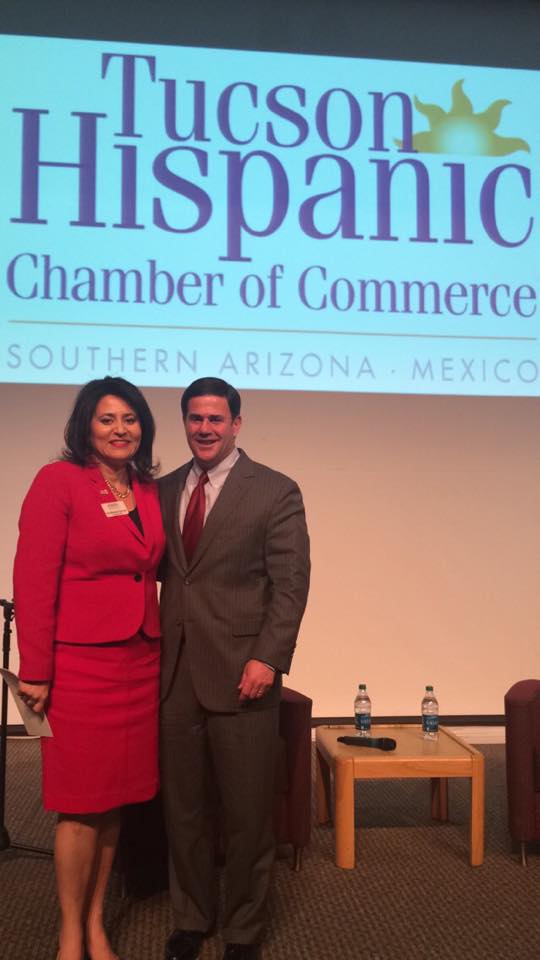 Our Tucson Hispanic Chamber was honored to host Governor Ducey’s inaugural Legislative Review Luncheon in Southern Arizona on May 1st. Governor Ducey took office just a short 120 days ago and set to work on balancing our State budget. This was a daunting task that created controversy as state resources were stretched to accommodate our needs and population growth.
Our Tucson Hispanic Chamber was honored to host Governor Ducey’s inaugural Legislative Review Luncheon in Southern Arizona on May 1st. Governor Ducey took office just a short 120 days ago and set to work on balancing our State budget. This was a daunting task that created controversy as state resources were stretched to accommodate our needs and population growth.
At the recent luncheon, I had a few moments to address the crowd and decided to focus on several specific challenges in our region to indicate the difference between doing business in Maricopa County and Pima County. These differences are important to recognize when considering policy changes and new legislation.
Our County has more than 300,000 people or 64% living in unincorporated areas. In comparison, Maricopa County is almost 95% incorporated. This impacts the way in which State shared revenue is allocated to our area. It is estimated that this structure loses the City of Tucson over $70 million dollars a year. This has also created over time two jurisdictions (Pima County and the City of Tucson) that each provide urban services and have a budget of over $1 billion dollars. We have struggled with regional government and annexation for decades. Our region has a heavy reliance on property taxes as compared to Maricopa County. Pima County is the only county without a sales tax. Therefore, our businesses pay higher property taxes as compared to Maricopa County. Our services are funded differently here.
Our economy in Southern Arizona is dependent on a few very large employers – namely, our local government, health care, education and Raytheon. Government budget cuts, locally or federally such as sequestration, have an even greater impact on our local businesses which serve as vendors to these large employers. Over 90% of the businesses in Southern Arizona are small businesses. The economic recovery of our small businesses has been slow but steady. As a chamber, we are champions of our small businesses which we work with to grow their revenues and understand that if they add even one employee each, it would have a dramatic impact on Arizona’s economy. This is important to know as we work to attract new businesses to our State and to our region – a priority to our Governor.
Our region also has different transportation needs than many other areas of the state. We lack the parkways and highways that Phoenix has up north and are dependent on our interior roadways. We are struggling now with road maintenance and have an estimated $1 billion dollar need in Pima County. There are several solutions – many long term – but most of the business community is committed to take on debt in the form of a Bond to tackle the most needy transportation corridors. A priority to Southern Arizona is the condition and maintenance of our roads and the importance of the corridors drawing commercial traffic from Mexico to I-10.
I also spoke about some of the very special, positive differences in Southern Arizona.
Our proximity to Mexico is one. Our community has a keen awareness of the importance of Mexican nationals to our economy and of the opportunity trade and tourism play to our businesses. In Pima County alone, Mexican nationals spend over $1 billion dollars a year. We work closely with our members in Pima County, Santa Cruz and Cochise Counties to build relationships with Mexican businesses and encourage tourism.
We celebrate our diversity in Southern Arizona. Pima County will be a majority Hispanic by 2030 per our US Census. The state of Arizona will be a majority Hispanic just five years later. Such significant demographic changes have impacted how we do business, who we hire, who we nominate to our Boards of Directors and more. Our community continues to work to improve high school graduation rates for all students, but certainly Hispanic students who have a higher dropout rate. We strongly support the effort to reform our State’s School Funding formula. The bottom line is that we have a funding formula that has not been updated in ages and has been “band aided” over the decades with changes. It’s time for a comprehensive analysis and a new funding formula that works for all of our schools.
I was honored to cochair Governor Ducey’s transition committee on Economic Development, Trade and Tourism with Arizona Chamber President Glenn Hamer. The Tucson Hispanic Chamber is committed to continue to work closely with the Governor’s staff on improving Arizona’s economy. Supporting and growing existing businesses, attracting new business and additional primary jobs to the region are a priority for our chamber.
Lea Marquez Peterson is the President/CEO of the Tucson Hispanic Chamber and its affiliate chambers in Sierra Vista, Douglas and Nogales. The chamber has over 1100 member businesses and was recognized as the 2013 National Hispanic Chamber of the Year.















More Stories
PIMA COUNTY HOSTS FEMA HIGH-CAPACITY COVID TESTING CENTER AT PCC WEST CAMPUS
Editor letter
This past month of April, The U.S. Census Bureau released congressional apportionment and population counts for every state.
Tucson City court closed this Friday and, on the holidays
Pima County opens another round of PPE Business Assistance
Sunnyside Foundation provides resources to enhance and accelerate the educational